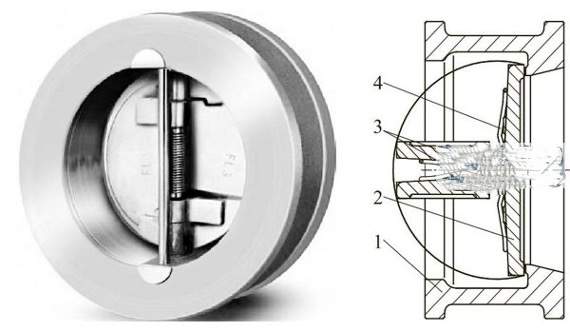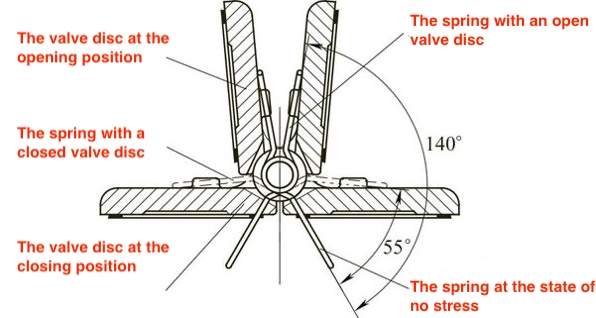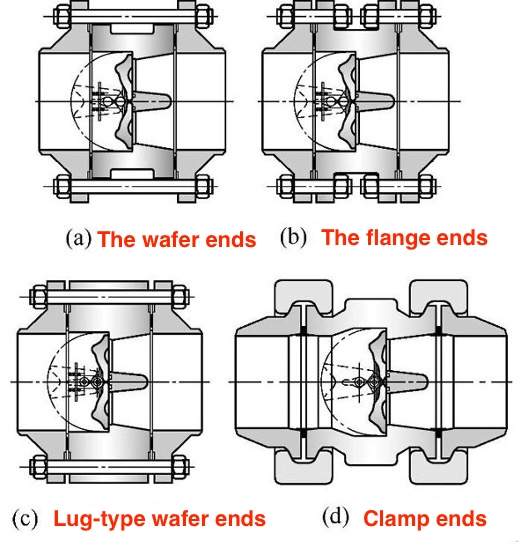Double Disc Butterfly Check Valves
The double-disc butterfly check valve is also a swing check valve, but it is a double-disc valve that closes under the action of a spring. The fluid from bottom to top pushes the valve disc. The double-disc butterfly check valve has a simple structure, and the wafer is installed between two flanges, with small dimensions and light weight, as shown in Figure 1.

Figure 1 Double disc butterfly check valves
Valve bodies 2. Valve discs 3. Pin shafts 4. Springs
The double-disc butterfly check valve has two spring-loaded D-shaped discs, which are placed on the rib shaft across the through hole of the valve. This structure shortens the moving distance of the center of gravity of the disc. Compared with the single disc swing check valve of the same size, this structure also reduces the weight of the disc by 50%. This valve reacts very quickly to reverse flow due to the spring load. The light double disc of the double-disc butterfly check valve makes the seat’s sealing and operation more effective. The long-arm spring action of the double disc butterfly check valve enables the disc to open and close without rubbing against the valve seat, and the spring acts independently to close the disc (DN150 and above). The hinge support sleeve of the double disc butterfly check valve reduces friction and minimizes water hammer when stopped by the independent disc (bigger sizes).
Compared with conventional swing check valves, double disc butterfly check valves are generally stronger, lighter, smaller, more efficient, and less expensive. This valve complies with the API 594 standard. For most diameters, the face-to-face size of this valve is only 1/4 of that of conventional valves, and its weight is 15% to 20% of conventional valves; it is also cheaper than swing check valves. It is also easier to install between standard gaskets and pipe flanges. Since it is easy to handle and requires only one set of flange connection bolts, it also saves parts during installation, saving installation costs and daily maintenance costs. The double disc butterfly check valve also has special structural features, which makes this valve a high-performance non-impact check valve. These features include no-clean opening, independent springs for valves with most sizes, and independent disc support systems. Some check valves do not have these features. Double disc butterfly check valves can also be designed with lug types, double flanges and extended valve bodies.
1. Opening and closing processes
The opening and closing process of the double disc butterfly check valve is shown in Figure 2.

Figure 2 Opening and closing processes of double disc butterfly check valves
(a) The disc is closed from the top view. (b) When the fluid starts to enter, the root will be opened. (c) The valve disc is fully open with an angle of 85 (d) When the fluid decreases, the front edge of the disc is closed first. (e) The valve seat is sealed, realizing an airtight closure.
The double-disc adopts two spring-loaded discs (half discs) suspended from a central vertical hinge pin. When fluid flow begins, the disc opens under the resultant force (F) acting on the center of the sealing surface. The acting point of the reacting spring support force (FS) is located outside the center of the disc face, causing the root of the disc to open first. This avoids friction on the sealing surface of the old conventional valve when the disc is opened, and eliminates the wear and tear of the components.
When the flow rate slows down, the torsion spring reacts automatically, so that the disc closes and approaches the valve seat of the valve body, reducing the closing stroke distance and time. When the fluid flows backward, the valve disc gradually approaches the valve seat of the valve body, and the dynamic response of the valve is greatly accelerated, which reduces the influence of the water hammer, thereby achieving non-impact performance. When the valve is closed, the action point of the spring force makes the top of the disc close first, preventing the chafing at the root of the disc, so that the valve can maintain the sealing integrity for a longer time.
2. Independent spring structure
The spring structure (diameter DN150 and above) enables greater torque to be applied to each valve disc, and the valve disc can be closed independently as the industrial liquid flow changes. Experiments have shown that this effect extends the valve’s service life by 25% and reduces water hammer by 50%. Each part of the double disc has its springs which provide independent closing force and experience a relatively small angular deflection of only 140°(Figure 3) instead of conventional springs with double brackets at an angle of 350.

Figure 3 Independent spring structure
3. Independent disc suspension
The independent hinge structure reduces friction by 66%, which greatly improves the response of the valve. The support sleeve is inserted from the outer hinge so that the upper hinge can be independently supported by the lower sleeve during valve operation. This allows both discs to react quickly and close simultaneously for excellent dynamic performance.
4. The connection method with the pipeline
The double disc butterfly check valve and the pipeline can be connected by wafers, lug-type wafers, flanges and clamps. See Figure 4 for the connection methods.

Figure 4 The connection method between the double disc butterfly check valve and the pipeline

Figure 1 Double disc butterfly check valves
Valve bodies 2. Valve discs 3. Pin shafts 4. Springs
The double-disc butterfly check valve has two spring-loaded D-shaped discs, which are placed on the rib shaft across the through hole of the valve. This structure shortens the moving distance of the center of gravity of the disc. Compared with the single disc swing check valve of the same size, this structure also reduces the weight of the disc by 50%. This valve reacts very quickly to reverse flow due to the spring load. The light double disc of the double-disc butterfly check valve makes the seat’s sealing and operation more effective. The long-arm spring action of the double disc butterfly check valve enables the disc to open and close without rubbing against the valve seat, and the spring acts independently to close the disc (DN150 and above). The hinge support sleeve of the double disc butterfly check valve reduces friction and minimizes water hammer when stopped by the independent disc (bigger sizes).
Compared with conventional swing check valves, double disc butterfly check valves are generally stronger, lighter, smaller, more efficient, and less expensive. This valve complies with the API 594 standard. For most diameters, the face-to-face size of this valve is only 1/4 of that of conventional valves, and its weight is 15% to 20% of conventional valves; it is also cheaper than swing check valves. It is also easier to install between standard gaskets and pipe flanges. Since it is easy to handle and requires only one set of flange connection bolts, it also saves parts during installation, saving installation costs and daily maintenance costs. The double disc butterfly check valve also has special structural features, which makes this valve a high-performance non-impact check valve. These features include no-clean opening, independent springs for valves with most sizes, and independent disc support systems. Some check valves do not have these features. Double disc butterfly check valves can also be designed with lug types, double flanges and extended valve bodies.
1. Opening and closing processes
The opening and closing process of the double disc butterfly check valve is shown in Figure 2.

Figure 2 Opening and closing processes of double disc butterfly check valves
(a) The disc is closed from the top view. (b) When the fluid starts to enter, the root will be opened. (c) The valve disc is fully open with an angle of 85 (d) When the fluid decreases, the front edge of the disc is closed first. (e) The valve seat is sealed, realizing an airtight closure.
The double-disc adopts two spring-loaded discs (half discs) suspended from a central vertical hinge pin. When fluid flow begins, the disc opens under the resultant force (F) acting on the center of the sealing surface. The acting point of the reacting spring support force (FS) is located outside the center of the disc face, causing the root of the disc to open first. This avoids friction on the sealing surface of the old conventional valve when the disc is opened, and eliminates the wear and tear of the components.
When the flow rate slows down, the torsion spring reacts automatically, so that the disc closes and approaches the valve seat of the valve body, reducing the closing stroke distance and time. When the fluid flows backward, the valve disc gradually approaches the valve seat of the valve body, and the dynamic response of the valve is greatly accelerated, which reduces the influence of the water hammer, thereby achieving non-impact performance. When the valve is closed, the action point of the spring force makes the top of the disc close first, preventing the chafing at the root of the disc, so that the valve can maintain the sealing integrity for a longer time.
2. Independent spring structure
The spring structure (diameter DN150 and above) enables greater torque to be applied to each valve disc, and the valve disc can be closed independently as the industrial liquid flow changes. Experiments have shown that this effect extends the valve’s service life by 25% and reduces water hammer by 50%. Each part of the double disc has its springs which provide independent closing force and experience a relatively small angular deflection of only 140°(Figure 3) instead of conventional springs with double brackets at an angle of 350.

Figure 3 Independent spring structure
3. Independent disc suspension
The independent hinge structure reduces friction by 66%, which greatly improves the response of the valve. The support sleeve is inserted from the outer hinge so that the upper hinge can be independently supported by the lower sleeve during valve operation. This allows both discs to react quickly and close simultaneously for excellent dynamic performance.
4. The connection method with the pipeline
The double disc butterfly check valve and the pipeline can be connected by wafers, lug-type wafers, flanges and clamps. See Figure 4 for the connection methods.

Figure 4 The connection method between the double disc butterfly check valve and the pipeline




